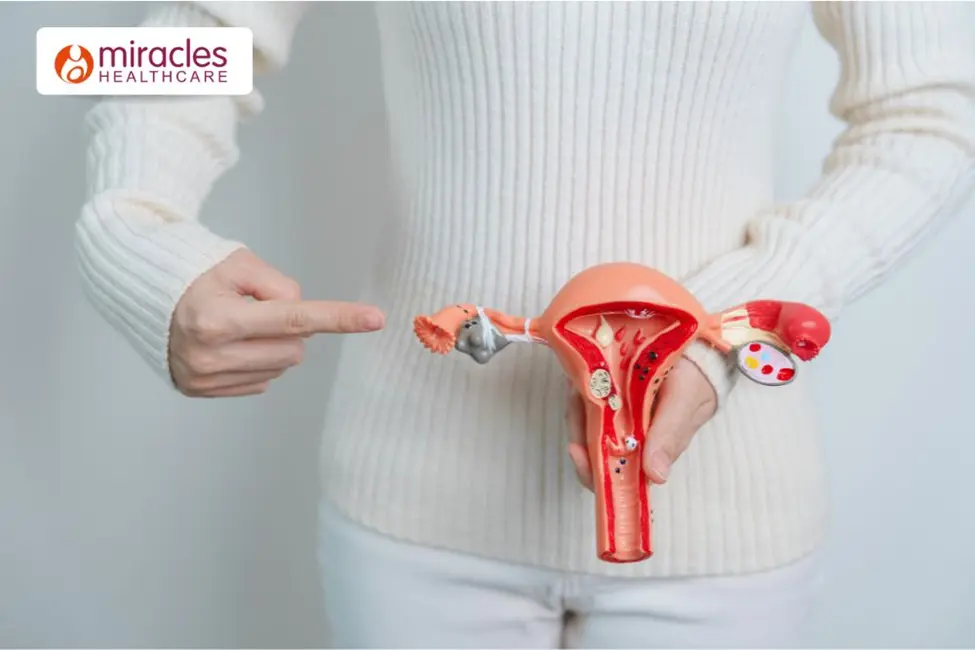When it comes to women’s health, some conditions remain silent until they start causing major problems. One such condition is ovarian cysts. These sacs, filled with fluid, develop on or within the ovaries and are quite common among women of childbearing age. Most of the time, they are harmless and go away without treatment.. However, some cysts can grow larger, become painful, or even lead to complications if left untreated.
The challenge is that ovarian cysts usually don’t show obvious symptoms. Many women may mistake the signs for something else, like normal period pain, indigestion, or even stress. Dr. Sadhna Sharma, the best gynaecologist in gurgaon, Miracles Healthcare explains, “Ovarian cysts are often silent, and women may not realize they have them until symptoms worsen. Paying attention to slight changes in your body can make early detection and treatment much easier.”
The Hidden Signs of an Ovarian Cyst
Ovarian cysts don’t always call for attention. Some women never notice them, while others experience symptoms that are often mistaken for other health issues. Here are the signs to watch out for:
1. Recurring Pelvic Pain
One of the earliest signs is mild to moderate pelvic pain. It often feels like a dull ache or heaviness in the lower abdomen, usually on one side. Unlike period cramps, this pain may appear in between cycles or linger longer.
2. Constant Bloating or a Feeling of Fullness
If your stomach feels swollen even without overeating, a cyst might be pressing against your abdomen. Unlike normal bloating that improves with dietary changes, bloating caused by cysts is persistent and uncomfortable.
3. Changes in the Menstrual Cycle
Hormonal changes from ovarian cysts can affect periods, leading to:
- Irregular cycles
- Heavier or lighter bleeding
- Spotting between periods
- Missed periods
If your cycle suddenly changes without a clear reason, it is advisable to consult a gynae doctor.
4. Pain During Intercourse
Painful intercourse (dyspareunia) is a hidden sign many women ignore. When a cyst presses on pelvic organs, it can cause sharp or deep pain during intimacy.
5. Frequent Urination or Trouble Emptying the Bladder
Large cysts can put pressure on the bladder, leading to frequent urges to urinate. In some cases, you may feel the urge but struggle to empty the bladder fully.
6. Lower Back or Thigh Pain
Unexpected pain in the lower back, hips, or thighs can also be related to ovarian cysts. The pressure of the cyst may affect nearby muscles and nerves, spreading discomfort beyond the pelvic area.
7. Difficulty in Conceiving
Not all ovarian cysts affect fertility, but conditions like polycystic ovary syndrome (PCOS) and endometriomas can make conception harder. If you are trying to get pregnant and facing difficulties, an undiagnosed cyst may be the reason.
8. Digestive Problems
Some women with cysts experience indigestion, constipation, or a heavy feeling after meals. These symptoms occur because the cyst takes up space in the abdominal cavity.
9. Nausea or Vomiting
Although not very common, nausea or vomiting may occur with large cysts, especially if a cyst ruptures or twists (ovarian torsion), this is a medical emergency and needs immediate attention.
Types of Ovarian cysts
There are different types of ovarian cysts:
- Functional cysts: The most common type, usually harmless and linked to the menstrual cycle.
- Dermoid cysts: They contain tissue like hair, skin, or fat.
- Endometriomas: Caused by endometriosis, where the uterine lining grows outside the uterus.
- Cystadenomas: Filled with watery or mucus-like fluid.
Smaller cysts often shrink on their own, but bigger or persistent ones might need medical care.
How are Ovarian Cysts Diagnosed?
Doctors use different methods to detect ovarian cysts, including:
- Pelvic examination to feel for swelling around the ovaries.
- Ultrasound scan to identify size, shape, and type.
- Blood tests to rule out other conditions or check hormone levels.
- CT or MRI scans for detailed imaging if needed.
Early diagnosis can help avoid complications and ensure proper treatment.
Ovarian Cysts Treatment Options
Treatment options vary based on the cyst’s size, type, and the symptoms it causes:
- Watchful waiting: Many small cysts disappear within a few months.
- Medications: Helps prevent new cysts from forming.
- Surgery: If the cyst is large, painful, or suspicious, doctors may remove it. Minimally invasive laparoscopic surgery is usually preferred.
Can Ovarian Cysts Be Prevented?
While you can’t fully prevent ovarian cysts, you can reduce risks by:
- Having regular pelvic check-ups.
- Monitor your periods and report sudden changes.
- Maintaining a healthy weight.
- Managing conditions like PCOS or endometriosis under medical guidance.
When Should You See a Doctor?
Not all cysts are harmful, but you should consult a gynecologist near you if you notice:
- Severe or sudden pelvic pain
- Rapid abdominal swelling or bloating
- Pain with fever or vomiting
- Irregular periods for several months
- Difficulty getting pregnant despite trying
These signs could point to a ruptured cyst, torsion, or other serious issues.
Conclusion:
Ovarian cysts are more common than many females realize, and most of them don’t cause harm. But sometimes, they bring hidden signs like pelvic pain, bloating, irregular periods, or difficulty urinating. Ignoring these signals can lead to complications, so it is always better to listen to your body. If you experience any unusual signs, make sure to visit a gynecologist near you. Early detection makes treatment easier and protects your reproductive health.
Also Read-Cash Home Buyers: A Stress-Free Way to Sell an Outdated Las Vegas Home Quickly
